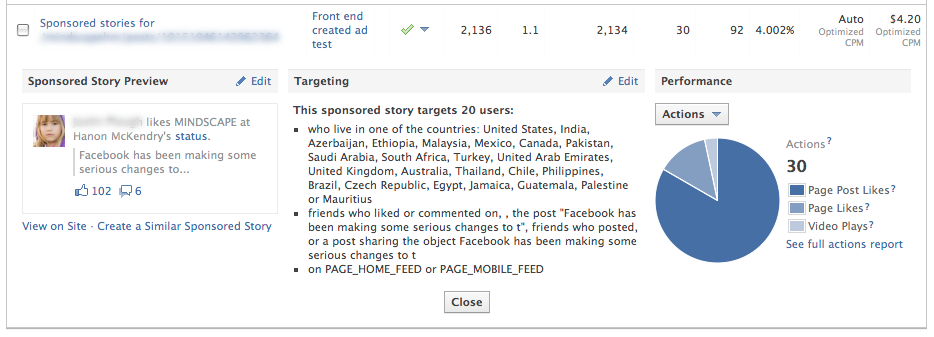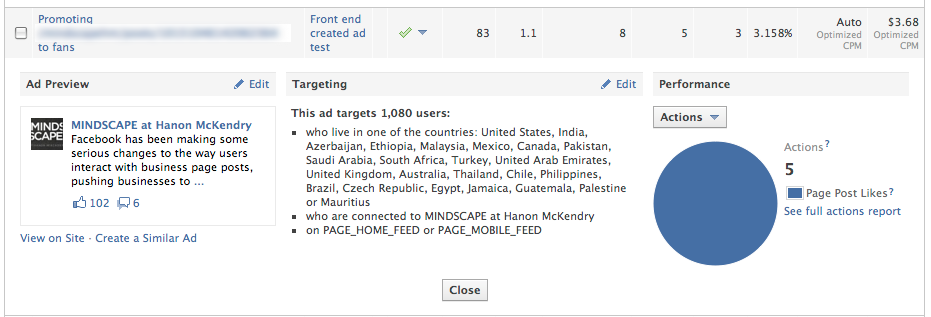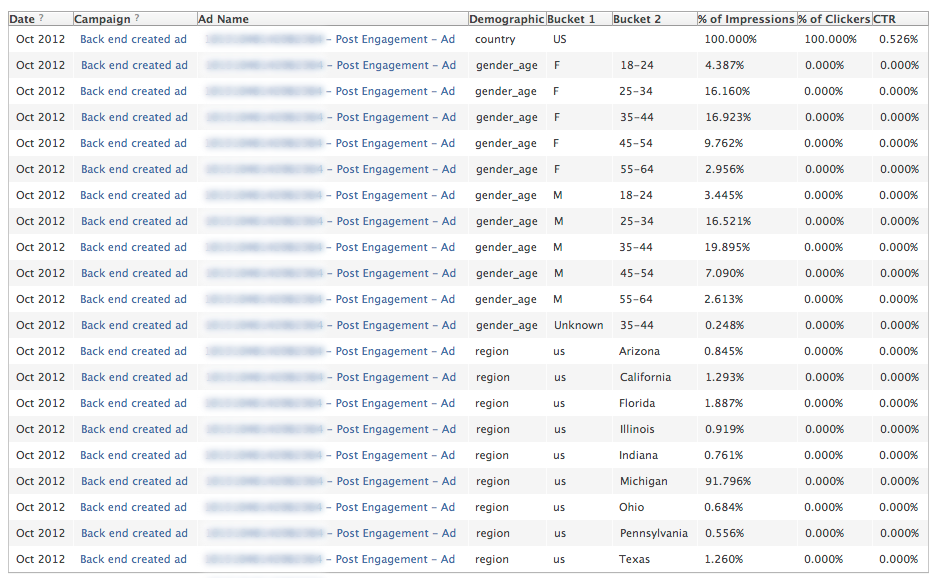This post was originally published on creativewebbusiness.com.
There’s been a bit of a kerfuffle lately in the Facebook marketing community regarding the changes the platform has been making to its newsfeed algorithms. Late in September, business pages began to notice engagement rates with their posts dropping through the floor. The reason is that REACH – the number of people seeing the company’s posts – has plummeted as a direct result of Facebook’s latest newsfeed algorithm changes. This has been going on slowly for many months, but this month it reached a head.
Facebook’s official statement regarding the algorithm changes is as follows:
“We’re continuing to optimize News Feed to show the posts that people are most likely to engage with, ensuring they see the most interesting stories. This aligns with our vision that all content should be as engaging as the posts you see from friends and family.”
Huh. So that’s how they’re going to play it.
It turns out, creating “engaging posts” simply isn’t enough for businesses anymore – not enough to get the kind of reach we’ve enjoyed previously. According to EdgeRank Checker, median engagement for business posts has dropped from .59% to .49% since September 20th. Median reach has gone from 26% to 19.5%, and viral reach has plummeted from .69% to .38%. Despite Facebook’s claims that these changes are about improving content quality in newsfeeds, the social network clearly has an ulterior, $$-related motive:
pushing business pages to pay for promoted posts.
At the same time the new algorithm was being put in place, Facebook began pushing another ad opportunity for businesses: promoted posts. This allows you to pay to advertise specific posts to your fan base and beyond.
Looking beyond the metric smoke and mirrors
So, there’s a lot going on here – too much to make a blanket “Facebook is screwing business pages!” type statement. Logistically, the drop in business pages’ organic reach to fans’ newsfeeds is inevitable; more users – business and personal – are posting more content, so naturally, each individual post gets less exposure, as there’s simply a bigger pool of content for the Facebook’s algorithms to pull from.
Notably, a June study from EdgeRank Checker noted that while reach dropped significantly between May and June on their 400+ accounts, there was simultaneously a clear spike in the ratio of engagement per post. In other words, while fewer posts were being seen, posts that WERE being seen were getting higher engagement.
Facebook is sticking to its guns, emphasizing these changes are about improving content quality for users. Like Panda and Penguin updates for SEOs, the process of weeding out the content chaff can be an excruciating and frustrating one for social media marketers and businesses.
Posting quality content that engages users should be the #1 goal of every business page. Eye-catching images; current topics and interesting events; relevant resources; these are the kinds of content business pages need to be posting.
HOWEVER, the timing between business pages’ drop in organic reach and the company’s push towards paid post advertising is too aligned for us to ignore the fact that content quality is not the only – or even main – goal Facebook is trying to achieve here.
Come on, Facebook. Like your investors, we weren’t born yesterday.
Promoted Posts – helping you reach more fans, more bots, or a waste of money?
First, a qualifier: I find Facebook’s ad management system incredibly convoluted and confusing. But I am a creative at heart, and navigating ad management systems has never been a particular strong suit of mine. If you find any errors or gaps in my interpretations of this data, please let me know; I’d be happy to hash it out in the comments section.
The Marketing Department here at Mindscape at Hanon McKendry decided to do a little data testing on promoted posts. We’d been hearing substantiated rumors that promoted post ads – which are supposed to target a page’s current fans – have been gathering a significant number of clicks from spamalicious origins – Taiwan, Malaysia, the Philippines.
That’s not good.
We also read that promoting posts stealthily creates not one, but multiple ads.
So we decided to test to see how or why these spammy foreign clicks are generated, what kind of reach promoted posts actually get, and what affect promoted posts have on engagement. Here’s what we found.

The test
For our Facebook page (with over 1,000 likes), we created two separate ads: one through the “promoted posts” button on our page’s main timeline, and one through the back end ad management system:
The ad created through the “promote post” button didn’t allow for any demographic targeting – it only allows you to choose between only people you like your page and those people plus their friends. We opted just for “people who like your page”. This ad was called a “promoting to fans” ad.
Once created, this ad spawned a second “sponsored story” ad.
I named this campaign “Front end created ad test”.
The backend-created ad, of course, allowed for very segmented demographic targeting. For this ad, we targeted people 22-60, in the US, who speak English, who are already connected to Mindscape’s Facebook page. When creating this ad, it gave the option (which was automatically selected) for creating a corresponding “sponsored story”.
I opted out of the “sponsored story”, leaving me with a single “post engagement ad”. This campaign was named “Back end created ad test”.
We let it run for a total of three days over the weekend. On the surface, the results were quite nice; for $20, we expanded the post’s reach (post reach had been averaging around 250-300/post) to almost 2,700, gathered 6 comments and almost 100 likes. Great!
But where was that money going, and where were these ads being displayed? Do promoted posts really work the way Facebook says they do?
Here’s what we found.



Ironically, the “promoting to fans” front end created ad – the ad which was supposed to help get more reach and engagement with existing fans – demonstrated by far the lowest performance, with a whopping reach of 83, a social reach of 8 and 3 clicks. Awesome. On top of this, the back end ad manager wouldn’t allow me to generate any reports for this ad. Not sure why, but double awesome.
The frontend-created “sponsored story” ad, on the other hand, generated a reach of over 2,000, with 30 actions, 92 clicks and a big 4% CTR. Good, right?
But then I compared that to the back end created ad’s performance and demographic reach.
As you can see above, the front end created ads targeted a broad range of foreign countries, by default.


The post engagement ad, predictably, shows most of our traffic from users in Michigan, with all traffic coming from within the US.
Now, look at the sponsored stories ad. Nearly 20% of the impressions were shown in the Philippines, with all remaining impressions confined to the US.
WHAAAT???
It would make sense if there were a few impressions in European and miscellaneous other countries, including Southeast Asia. After all, sponsored stories are supposed to be shown to friends of fans, and inevitably many of our fans have friends in other countries. What DOESN’T make any sense is that the Philippines is the ONLY country outside the US in which ads are shown and that it’s such a high percentage.
Now, let’s go back and compare engagement metrics between the front end sponsored story ad and the back end post engagement ad.
The post engagement ad’s reach and CTR are much lower than the sponsored story’s (as was its price – roughly 1/8th the cost of the front end ad), and the sponsored story’s # of clicks were higher, but look at the number of actions. “Actions” are a bit ambiguous here, but they’re undoubtedly our core engagement metric – people liking the post and/or page, commenting, etc.
The sponsored story ad’s # of actions is 30. The post engagement ad’s # of actions is 77.
Divide that by each ad’s reach, and you get an engagement rate of 10% for the post engagement ad and a mere 1.4% for the sponsored story.
So…yeah. Turns out, all that “reach” the sponsored story gathered did far less than the more tightly targeted, sidebar post engagement ad. From where I’m sitting, it looks like the lack of demographic targeting – which is, strangely, built in to the “promote post” front end ad manager – is to blame.
Takeaways
Promoting to fans ads
These are clearly a joke. Which is funny, because one of the main purposes of promoting posts is to get higher reach within your existing fan base. If anyone out there has evidence to the contrary, I’d love to see it.
Sponsored stories
I’m torn on these, and honestly just need to do more testing, next time from the back end. My gut tells me that a backend-created sponsored story which is given the correct demographic targeting (to weed out spammy international clicks) might be the sweet spot for a high reach and engagement ratio.
Post engagement ad
While not giving you the reach (if demographically targeted) of a sponsored story, these seem to offer the highest engagement to reach ratio and, importantly, by far the lower cost. If I were to do it again, I would run a post engagement ad and a sponsored story ad (created through the back end) side by side to gain both exposure and engagement.
Using the “promote post” button from the front end
– Instinctively, I distrust any ad management system which limits – or eliminates entirely – my ability to target demographics. Demographic segmentation has been, in my view, the most valuable part of Facebook’s ad platform thus far, and I’m a bit appalled that they’ve pulled this from their front end ad management system. Even more, the fact that this ad creator AUTOMATICALLY CREATES a sponsored story in stealth mode, without even telling you it’s doing so, is just plain stinky. The lack of transparency here is really quite appalling.
It IS, I should note, possible to go into the backend ad management system once you’ve created a promoted post from the front end and tweak targeting, but if you have to do that, what’s the point of using the “promote post” button in the first place?
Steer clear of it, if you ask me.




